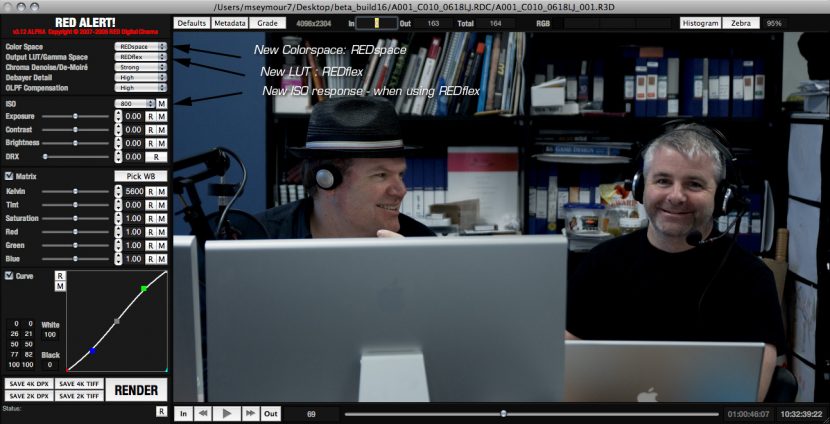In this week’s Red Centre the guys finally talk about build 16 and explain both the immediate benefit of the new version and also explain some of the the theory behind the improvements. Plus News, Reviews and the Red Room.
If you haven’t already, subscribe to the RSS feed or iTunes podcast on our redcentre page.
Click through for a summary of the Red Build 16 improvements, including the difference between the new RedSpace and and RedFlex colourspaces.
Build 16 provides a range of new operational benefits and improvements to the Red One Camera.
• 4:4:4 full HD playback from the Camera (or 4:2:2 HD, or clean 720P)
• Addition of Pre-Record (10 sec or 30 sec loop) mode.
• New RED-EVF control over Audio, Shutter, ISO and Varispeed parameters
• Improved display precision and color response of RED-EVF and RED-LCD.
• Extended exposure times of up to 1/2 sec enabled in TIMELAPSE menu
• User programmable Tonal Response Curves menu, or User “Looks” loaded on the camera via SD card
• Improved indiction of image magnify ‘focus’ mode with new “X” cursor on the screen.
• Bug Fixes
For fxguide it is the improvements in post-production workflow, and separation of Sensitivity (ISO) and Exposure (Compensation) parameters. In the newest version of the Red workflow there is a significant shift. It both makes general operation simpler and increases the importance of the ‘transfer’ of red’s .r3d files to say dpx files.
Initially Red Alert software is the only available program for processing the new .r3d files.
Red Alert now offers a new colourspace to work in called “RedSpace” and a new output LUT/Gamma space “RedSpace”and “RedFlex”. All digital cameras need to take the natural sensor data, matrix it to a colorspace. Typically in RED this would be either CameraRGB2 or Rec709 prior to build 16. Now that is expanded to include a new “RedSpace”. This new colour space is a better place to work in for a hassle free, high dynamic range, full 12 bit colourspace when doing .r3d work.
Once the matrixing is done, one has always been able to output the images in a range of log and video gamma formats such as RedLog, PD685, and Rec709. Now these are extended with both “RedSpace” and “RedFlex”. The first, RedSpace, is a recommended normal output LUT for those wanting ‘normal’ pictures with full range. It behaves in much the same way as classic film theory : a stop difference added in Red Alert to ISO (say 320 to 640) is completely balanced out with a matching -1 stop in exposure. Adjust one by a stop is equal to one stop adjustment in the other.
The second, RedFlex, does not work like this. It effectively changes the data distribution between the black and white point. So dropping the ISO no longer moves the whole histogram to the left, it does make the image darker but the whites at the top end remain in the same place, and so does the black point. The net result is that the image feels as if it has had a sort of curves adjustment rather than a lift adjustment when the ISO is adjusted. And a stop adjustment in ISO no longer exactly matches a Stop in Exposure. BUT an ISO stop adjustment does change the image by a stop in the mid tones, it just feathers that out into the highlights. Highlights are softly rolled off instead of being clipped.
This is more fully explained in this week’s Red Centre podcast and full discussed in fxphd’s red course at fxphd.com.
Click for a larger view


Note the current build of Red Alert has a note that
REDAlert! SUMMARY:
New Features: Build 16 file format support, 4k 16:9 support, REDspace support, QT wrappers now generate audio track, Full (_F) QT wrapper generation
Known Bugs: On Tiger, the colorspace and gammaspace menus aren
Thanks guys, another brilliant summary and update. Look forward to #9.
Hi,
I know this is a bit late, but I have a question to the Redspace/Redflex output LUT/Gamma.
Should I use Redflex/Redspace when I know I do just a Tv out? I use FCP for editing and Apple Color for grading… When I grade it in Color do I need a LUT?
I love your show and wanted to thank you!!!
best regards
lee